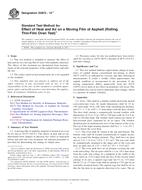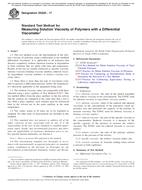1.1 These test methods cover the determination of soil water characteristic curves (SWCCs) for desorption (drying). SWCCs describe the relationship between suction and volumetric water content, gravimetric water content, or degree of water saturation. SWCCs are also referred to as soil water retention curves, soil water release curves, or capillary pressure curves.
1.2 This standard describes five methods (A-E) for determining the soil water characteristic curve. Method A (hanging column) is suitable for making determinations for suctions in the range of 0 to 80 kPa. Method B (pressure chamber with volumetric measurement) and Method C (pressure chamber with gravimetric measurement) are suitable for suctions in the range of 0 to 1500 kPa. Method D (chilled mirror hygrometer) is suitable for making determinations for suctions in the range of 500 kPa to 100 MPa. Method E (centrifuge method) is suitable for making determinations in the range 0 to 120 kPa. Method A typically is used for coarse soils with little fines that drain readily. Methods B and C typically are used for finer soils which retain water more tightly. Method D is used when suctions near saturation are not required and commonly is employed to define the dry end of the soil water characteristic curve (that is, water contents corresponding to suctions > 1000 kPa). Method E is typically used for coarser soils where an appreciable amount of water can be extracted with suctions up to 120 kPa. The methods may be combined to provide a detailed description of the soil water characteristic curve. In this application, Method A or E is used to define the soil water characteristic curve at lower suctions (0 to 80 kPa for A, 0 to 120 kPa for E) near saturation and to accurately identify the air entry suction, Method B or C is used to define the soil water characteristic curve for intermediate water contents and suctions (100 to 1000 kPa), and Method D is used to define the soil water characteristic curves at low water contents and higher suctions (> 1000 kPa).
1.3 All observed and calculated values shall conform to the guide for significant digits and rounding established in Practice D 6026. The procedures in Practice D 6026 that are used to specify how data are collected, recorded, and calculated are regarded as the industry standard. In addition, they are representative of the significant digits that should generally be retained. The procedures do not consider material variation, purpose for obtaining the data, special purpose studies, or any considerations for the objectives of the user. Increasing or reducing the significant digits of reported data to be commensurate with these considerations is common practice. Consideration of the significant digits to be used in analysis methods for engineering design is beyond the scope of this standard.
1.4 The values stated in SI units are to be regarded as standard. No other units of measurement are included in this standard.
1.5 Warning–Mercury has been designated by EPA and many state agencies as a hazardous material that can cause central nervous system, kidney, and liver damage. Mercury, or its vapor, may be hazardous to health and corrosive to materials. Caution should be taken when handling mercury and mercury-containing products. See the applicable product Material Safety Data Sheet (MSDS) for details and EPA's website (http://www.epa.gov/mercury/faq.htm) for additional information. Users should be aware that selling mercury or mercury-containing products, or both, in your state may be prohibited by state law.
1.6 This standard does not purport to address all of the safety concerns, if any, associated with its use. It is the responsibility of the user of this standard to establish appropriate safety and health practices and determine the applicability of regulatory limitations prior to use.
Product Details
- Published:
- 09/01/2008
- Number of Pages:
- 20
- File Size:
- 1 file , 1.2 MB


